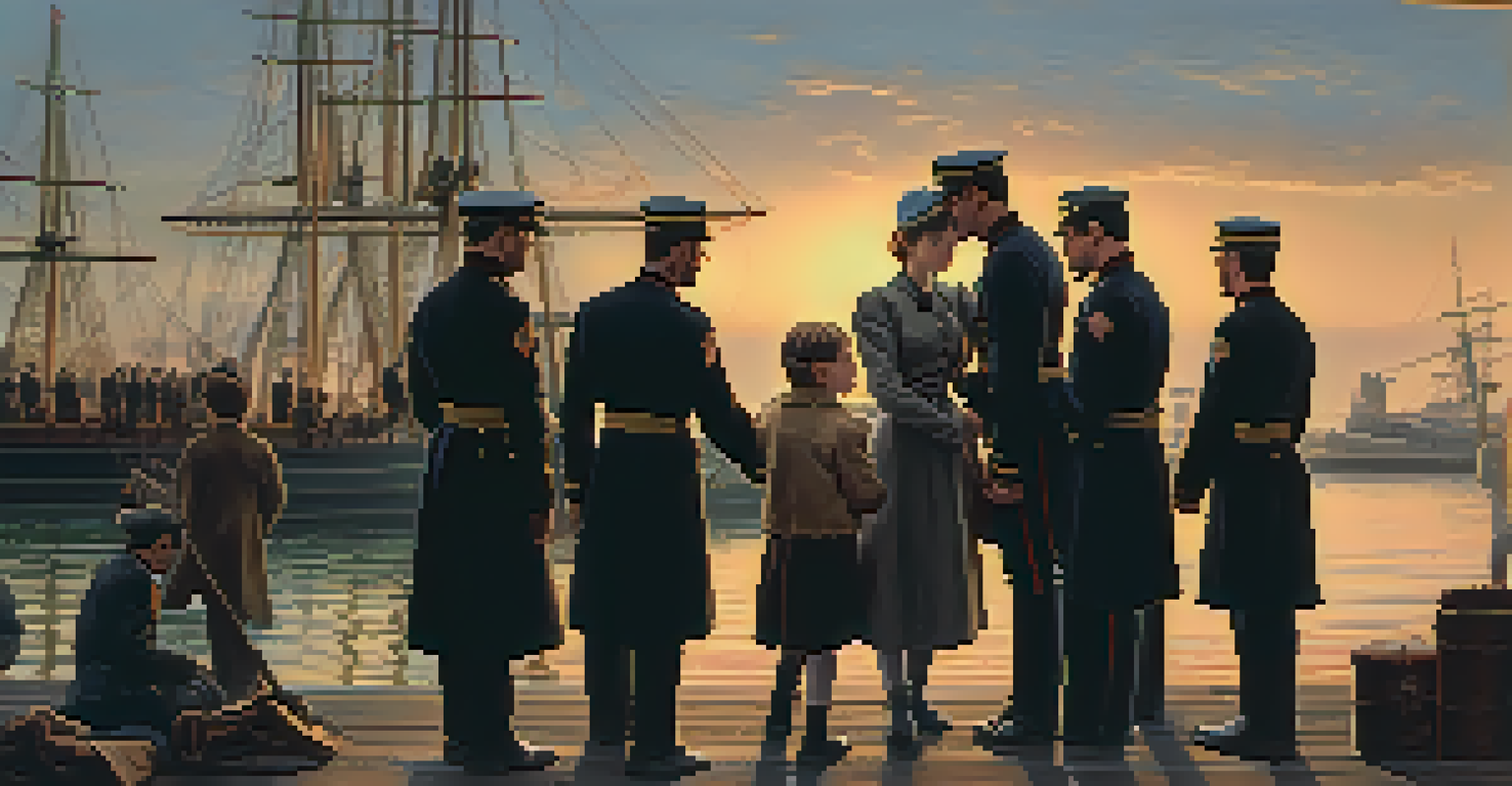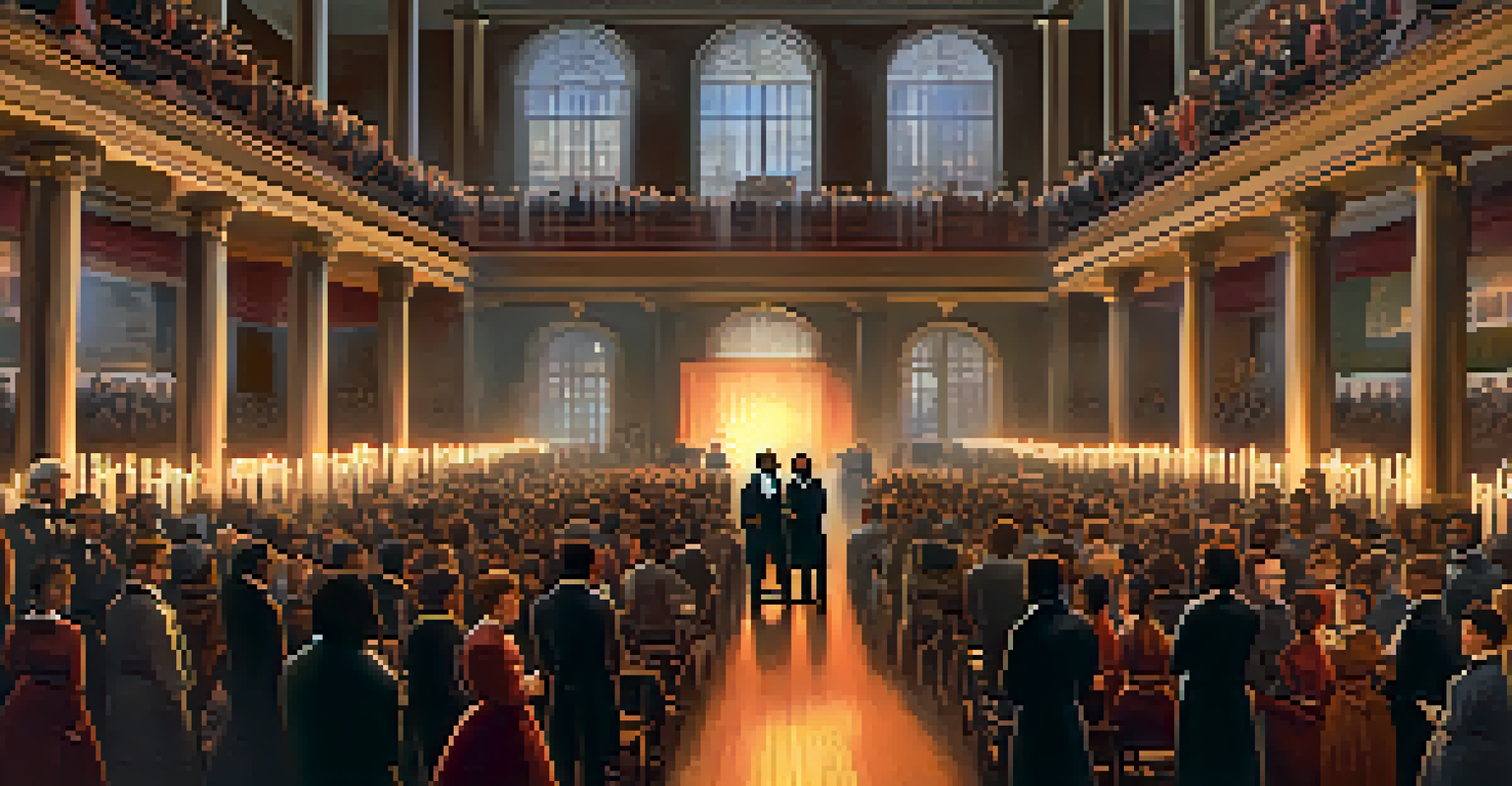The Civil War Era: NYC's Divisions and Contributions Explained

New York City's Complex Social Landscape During the Civil War
New York City in the 1860s was a melting pot of cultures, ideas, and conflicts. The social fabric was woven with various immigrant populations, each bringing their unique perspectives and experiences. This diversity often led to divisions, particularly around the contentious issues of slavery and the war itself.
Freedom is never given; it is won.
For instance, Irish immigrants, many of whom were struggling for their place in American society, often found themselves at odds with abolitionists. This tension was particularly evident in the lead-up to the war, where differing opinions on slavery ignited fierce debates among the city's populace.
Consequently, these social divisions would manifest in various ways, including protests, riots, and even violent confrontations, painting a complex portrait of a city grappling with its identity amidst a national crisis.
Economic Motivations: NYC's Role in the War Effort
While social divisions were prevalent, New York City's economy was deeply intertwined with the war effort. The city served as a crucial hub for financing and supplying the Union Army, with its banks and businesses playing a significant role in funding military operations. This economic involvement created a sense of urgency and responsibility among many New Yorkers.

Wealthy merchants and financiers saw the war as an opportunity to expand their fortunes, leading to a surge in war-related industries. From arms manufacturing to fabric production for uniforms, the city's economy thrived on the wartime demand, showcasing a different kind of unity among its residents.
Social Divisions During the War
New York City's immigrant populations faced significant social tensions, particularly surrounding the issues of slavery and the Civil War.
However, this economic boom also highlighted disparities, as those benefiting from the war often clashed with working-class citizens who faced the brunt of conscription and labor shortages. The economic motivations of New York City were thus a double-edged sword, fueling both progress and conflict.
The Draft Riots: A Dark Chapter in NYC's History
One of the most notorious events reflecting the city's divisions was the Draft Riots of 1863. Triggered by the implementation of the draft, which many working-class citizens viewed as unfair, the riots spiraled into widespread violence and chaos. The anger was fueled by fears of losing jobs to freed slaves and resentment towards wealthier citizens who could avoid the draft by paying a fee.
The greatest of all evils is the lack of the human spirit.
For four days, from July 13 to July 16, the streets of New York erupted in violence, leading to the deaths of hundreds and the destruction of property. The riots starkly illustrated the underlying racial tensions and class struggles within the city, revealing how deeply divided the populace truly was.
This turbulent episode not only showcased the city's frustrations but also served as a grim reminder of the sacrifices and struggles faced by many during the Civil War era. The Draft Riots left an indelible mark on New York City’s history, highlighting the complexities of its social dynamics.
Abolitionist Movements: Voices for Change in NYC
Amidst the chaos and division, New York City also emerged as a center for abolitionist movements. Influential figures like Frederick Douglass and Sojourner Truth visited the city to speak out against slavery, rallying support for the Union cause and the emancipation of enslaved individuals. These voices were crucial in shaping public opinion and mobilizing citizens.
Abolitionist societies, such as the New York Anti-Slavery Society, organized lectures, protests, and fundraising events, demonstrating a collective commitment to the fight against slavery. They worked tirelessly to promote the idea that freedom and equality were fundamental rights for all, regardless of race.
Economic Growth Amidst Conflict
The city's economy thrived on war-related industries, yet this prosperity highlighted stark disparities between wealthy merchants and struggling working-class citizens.
However, these efforts were met with fierce opposition from pro-slavery factions, leading to heated debates and sometimes violent confrontations. The abolitionist movement in NYC was a testament to the city's complexity, showcasing both the fervor for change and the resistance to it.
Cultural Contributions: Art and Literature in Wartime NYC
Despite the turmoil, New York City continued to thrive culturally during the Civil War. Artists and writers used their talents to comment on the war, challenge societal norms, and inspire change. The work produced during this time reflected the city's struggles and aspirations, capturing the essence of a nation in crisis.
For example, the poetry of Walt Whitman, who lived in NYC during the war, expressed both the horrors of battle and the hope for a unified future. His famous collection, 'Drum-Taps,' resonated with many, illustrating the emotional landscape of the time and providing a voice for the common soldier.
Similarly, theatrical productions began to address contemporary issues, using satire and drama to engage audiences. This cultural output not only provided an escape from the harsh realities of war but also fostered a sense of community among New Yorkers, uniting them through shared experiences and artistic expression.
NYC's Role as a Gateway for Soldiers and Supplies
New York City was more than just a battlefield; it functioned as a significant gateway for soldiers and supplies heading to the front lines. The city's ports were bustling with activity as ships arrived and departed, transporting troops and essential resources to support the Union Army. This logistical hub played a crucial role in sustaining the war effort.
Many soldiers passed through NYC on their way to battle, often stopping to say goodbye to family and friends. The city served as a poignant backdrop for these farewells, highlighting the emotional toll of the war on countless families. Stories of bravery and sacrifice emerged, painting a vivid picture of the human experience during wartime.
Cultural Flourishing Despite Turmoil
Artists and writers in New York City produced impactful works that reflected the emotional landscape of the Civil War, fostering a sense of unity among its residents.
Moreover, the influx of soldiers brought about a unique camaraderie among the diverse populations of the city. The shared experience of war fostered connections that transcended social divisions, if only temporarily, showcasing the resilience of the human spirit in the face of adversity.
Legacy of the Civil War: NYC's Lasting Impact
The legacy of the Civil War era continues to resonate in New York City today. The divisions and contributions of this period laid the groundwork for the city's identity, influencing its social, economic, and cultural landscapes. The struggles faced during the war catalyzed changes that would shape the future of the metropolis.
In particular, the abolitionist movements and the fight for civil rights that emerged from this tumultuous time have left a lasting impact. The echoes of activism can still be felt, as New Yorkers continue to advocate for equality and justice, drawing inspiration from the lessons of their predecessors.

As we reflect on this pivotal chapter in history, it's essential to recognize the complexities of New York City's role during the Civil War. The interplay of division and unity, conflict and progress, serves as a reminder of the city's resilience and capacity for change, making it a vital part of America's narrative.